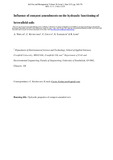JavaScript is disabled for your browser. Some features of this site may not work without it.
| dc.contributor.author | Whelan, A. | |
| dc.contributor.author | Kechavarzi, C. | |
| dc.contributor.author | Coulon, Frederic | |
| dc.contributor.author | Sakrabani, Ruben | |
| dc.contributor.author | Lord, R. | |
| dc.date.accessioned | 2020-04-07T15:58:46Z | |
| dc.date.available | 2020-04-07T15:58:46Z | |
| dc.date.issued | 2013-01-21 | |
| dc.identifier.citation | Whelan A, Kechavarzi C, Coulon F. (2013) Influence of compost amendments on the hydraulic functioning of brownfield soils. Soil Use and Management, Volume 29, Issue 2, June 2013, pp. 260-270 | en_UK |
| dc.identifier.issn | 0266-0032 | |
| dc.identifier.uri | https://doi.org/10.1111/sum.12028 | |
| dc.identifier.uri | http://dspace.lib.cranfield.ac.uk/handle/1826/15383 | |
| dc.description.abstract | This study assessed the impact of compost on the hydraulic properties of three soils (sandy loam, clay loam and diesel-contaminated sandy loam) with relatively poor physical quality typical of brownfield sites. Soils were amended with two composts at 750 t/ha. Samples were also collected from a clay-capped brownfield site, previously amended with 250, 500 or 750 t/ha of compost. Water-release characteristics and saturated hydraulic conductivity were determined for all soils and physical quality indicators derived. Unsaturated flow in field profiles after compost application with two depths of incorporation and two indigenous subsoils was simulated using Hydrus-1D. Compost generally increased water retention. Hydraulic conductivity tended to decrease following compost application in sandy loam but increased in clay and clay loam, where compost addition resulted in a larger dominant pore size. Although compost improved physical quality indicators, they remained suboptimum in clay and clay loam soil, which exhibited poor aeration, and in the contaminated sandy loam, where available water capacity was limited, possibly due to changes in wettability. Increasing application rates in the field enhanced water retention at low potentials and hydraulic conductivity near saturation but did not alter physical quality indicators. Numerical simulation indicated that the 500 t/ha application resulted in the best soil moisture regime. Increasing the depth of incorporation in the clay cap improved drainage and reduced waterlogging, but incorporation in more permeable subsoil resulted in prolonged dry conditions to greater depths. | en_UK |
| dc.language.iso | en | en_UK |
| dc.publisher | Wiley | en_UK |
| dc.rights | Attribution-NonCommercial 4.0 International | * |
| dc.rights.uri | http://creativecommons.org/licenses/by-nc/4.0/ | * |
| dc.title | Influence of compost amendments on the hydraulic functioning of brownfield soils | en_UK |
| dc.type | Article | en_UK |
Files in this item
The following license files are associated with this item:
This item appears in the following Collection(s)
-
Staff publications (SWEE) [2825]

